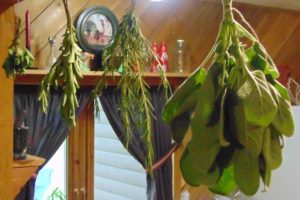How to Dry Herbs-5 Easy Ways
Growing and drying herbs kinda sorta go hand in hand. And it’s the best way to ensure that what you’re using in your food is natural and fresh…or freshly dried.
If you’re an old hand at drying and storing herbs, that’s awesome and I’d love to hear from you! If you’re new to herbs, then you’ll want to educate yourself on all the ways that you too, can dry and store herbs to get the most out of them.
As I mentioned in this post about the easiest herbs to grow, it’s important to know the herbs well. Some have more water content than others. For this reason, they may take longer to dry, depending on the method you use.
And then there are some herbs that will retain their flavor better by freezing…but that subject is for another post.
Not sure which herbs to grow? Start here!
Here are a few tips to keep in mind before you start:
- Cut herbs in the morning, after the dew has dried but before it gets hot. Cutting at the wrong time can affect the essential oils produced by the plant and you could miss out on all that goodness.
- Harvest leaves before the plant blooms. If a plant starts to produce a flower, simply pinch off the flower head. This will keep the plant’s energy focused on producing new leaves.
- Don’t use herbs that have been treated with pesticides. Although many products on the market today may be safe to use in gardens, most have not been approved for use on herbs that are intended for ingestion. Better safe than sorry.
- Use only fresh, healthy-looking leaves. No matter which method of drying you choose, quality in = quality out.
- Label your herbs. Most herbs all look the same after they’re dried. Unless you only have one plant, a month from now after they’re dried, you’ll forget which herbs are which. Trust me on this!
 Method #1-Hang Dry
Method #1-Hang Dry
This is probably the most common and preferred method for most folks. As you can see from the photo, it is also mine.
A couple of years ago, we took out a wall between our kitchen and dining room and put in a bar/counter.
Hubby was kind enough to put up some small nails so I could hang herbs above the bar. I like hanging herbs because they’re pleasing to my eye and they make the place smell good.
A kitchen is generally not the best place to dry herbs due to the heat and humidity from cooking. But this area of our home gets good air flow and my herbs are generally dried within 2-3 weeks. That’s pretty good since most herbs can take up to 4 weeks or longer to dry completely.
Some folks like to put paper bags or cheese cloth over their hanging herbs to keep out dust and dirt. Because I like to see my herbs and revel in the beauty of them, I choose not to use bags. For me, out of sight is also out of mind. I might forget to check on them for a very long time. Not that that has ever happened….much.
Method #2-Dehydrator
I’ll be honest, I only use my dehydrator when I want dried herbs in a hurry. Since not all dehydrators are the same, you’ll need to follow the directions listed in the owners manual for your particular unit. Still, it’s a great option and gets the job done quickly.
Method #3-Oven
I tried oven drying before I bought my dehydrator. It works but you really have to pay attention to the oven temp and the amount of time the herbs spend in the oven. Most oven temps can’t go low enough to keep the herbs from burning.
A work-around is to set your oven temp on it’s lowest setting and leave the oven door cracked open. Not all ovens heat to the same degree so you really have to devote your full attention to this drying process to ensure the herbs don’t get scorched.
Something to consider: the open oven door is going to be heating up your kitchen. Maybe use this method when it’s cooler outside to save on the heating bill.
Method #4-Microwave
Talk about quick and easy! Simply lay your herbs out on a paper towel in a single layer. Microwave 1-3 minutes at a time, turning the herbs over every 30 seconds until required dryness level is achieved.
I have also tried this method prior to buying a dehydrator. My microwave must have been too powerful because I totally destroyed a batch of spearmint on my first attempt!
I’m blaming the microwave because it can’t defend itself. And I’m pretty sure it wasn’t my lack of patience that had me skipping the “turn every 30 seconds” step. At least…I’m pretty sure.
Method #5-Sun
Ahhh yes! The good, old-fashioned way of drying anything! This is not a method I have tried because it is just too humid where I live in Texas. If you have tried it with any success, please let me know. I’d love to hear how well (or not) it works.
For everyone else, if you decide to try this method, make sure to use a paper bag and hang the herbs where they can get full sun until dried.
One more thing…
Now that you know the options available for drying herbs, here’s something to keep in mind: not all herbs should be dried.
Say whaaat?
It’s true. Some herbs lose their color, flavor and even medicinal benefits when dried. Others hold on to their flavor longer with freezing. The herbs you choose and their intended use should determine which preservation method is best.
If you’ve got plant material to spare, try drying a little and freezing a little. See which works best for your purpose. I can’t say it enough…know your herbs well.
Storage
Once your herbs are completely dry, store them in a container with a tight lid.
It’s best to store leaves whole and then crush them when you’re ready to use them. This way, they retain their flavor longer.
Whole or crushed, you’ll want to use them up within a year. If you can’t bring yourself to toss out perfectly good herbs, just be aware that they start to lose flavor and medicinal properties after a year.
Instead of tossing expired herbs in the trash, I throw them in the hens nesting boxes. The jury is still out on whether this does the hens any good…but at least it makes me feel better! You could also donate them to the compost pile, if you have one.
I love these little jars for storing my herbs.
The half pints are easy to stack and I can actually get a measuring spoon inside both of them. I found both at my local Tractor Supply store.
I also make a note on the label with the date they were stored. Makes it easier to track when they’re reaching expiration. This way I know when to start the next drying evolution and avoid running out of herb altogether. A cool, dry place is best for storing your herbs. Not on top of, or near the stove.
Just sayin’.
And no matter what, ALWAYS toss out any herbs that have the slightest hint of mold. Again, better safe than sorry!
So there you have it…so many options for drying and storing herbs. If you’ve never tried it, I hope this encourages you to try growing and drying herbs yourself. If you’re an old pro, I’d love to hear from you!
Until next time,
lisa
If you like what you see, click on the subscribe button so you don’t miss anything!
I promise not to spam you! By clicking the subscribe button, you agree to my privacy policy.






